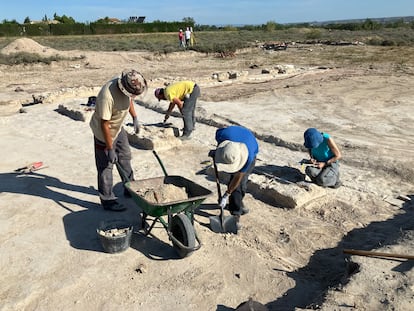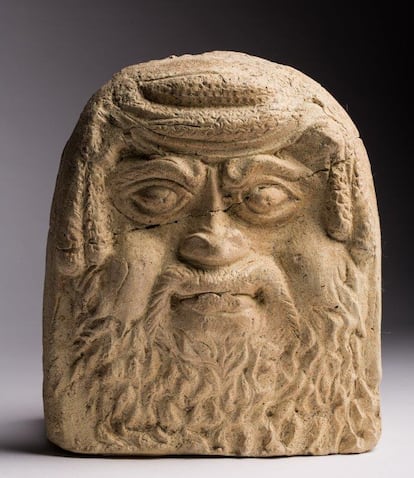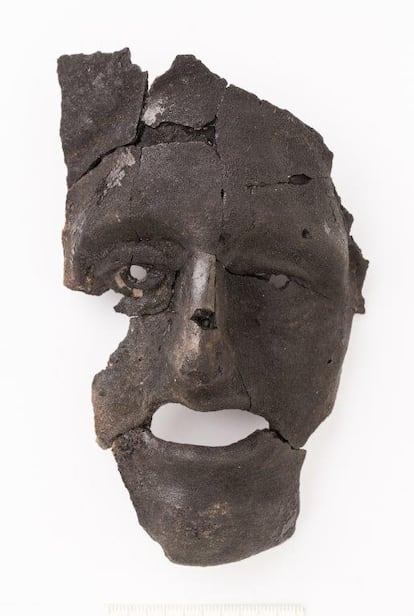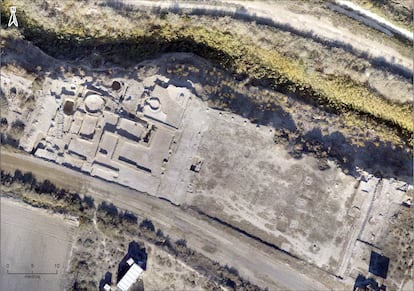The oldest Roman forum in Hispania has been found in Zaragoza
Experts believe that the square, ‘of monumental dimensions,’ was part of an unknown city razed to the ground in 70 B.C. during the Sertorian civil war


The Sertorian War was a bloody military conflict that took place in Hispania, between the years 82 B.C. and 72 B.C. and between the two factions that disputed power in Rome: the populares of Quintus Sertorius and the optimates of Quintus Caecilius Metellus and Gnaeus Pompeyus Magnus. The various peoples that inhabited the Iberian Peninsula at that time took part on one side or the other due to the dangers that threatened them, while trying to avoid the destruction of their settlements or the murder of their compatriots. And this was exactly what happened to a city located in the current municipality of El Burgo de Ebro (Zaragoza, Spain), which was completely destroyed around 70 B.C., just two generations after being built. The destruction of a city could be total if its people had chosen the wrong side. Now, excavations by the Institute of Heritage and Humanities of the University of Zaragoza, co-directed by Alberto Mayayo and Borja Díaz, have found the forum — the most important part of a Roman city and where its most prominent political and religious institutions were located — which is considered the oldest ever unearthed in the interior of Spain. The name of this Roman city on the banks of the Ebro remains unknown, although some experts believe that it could be Castra Aelia, a second line Roman camp that became a city with a huge forum, after the defeat of the Celtiberians in Numancia.
The site at La Cabañeta, the name given to the place where the city stood, was discovered in the 1980s in a survey carried out by the Department of Antiquity Sciences of the University of Zaragoza. The research began because there was an 18th century hermitage in the area that the local residents called Zaragoza la Vieja. Tradition said that Christians had taken refuge there during the persecutions of the 3rd century. The first archaeological investigations confirmed that the religious building was in the vicinity of a site dating from the time of the Roman Republic (2nd-1st centuries BC). About 20 years ago, archaeologists Antonio Ferreruela Gonzalvo and José Antonio Mínguez Morales excavated the place to determine how well the remains had been preserved. They also reviewed old aerial photographs, which allowed them to conclude that the city was protected by a large moat.
Luck was also on their side, and they found an extensive warehouse building, in one of whose rooms there was a pavement with a Latin inscription that referred to renovation works carried out by the representatives (magistri) of a merchants association. Likewise, at the northern end of the site, right at the end of the river terrace on the banks of the Ebro, the remains were found of very well-preserved thermal baths associated with a porticoed arena. In the end, they confirmed that it was an urban site founded in the last third of the 2nd century B.C., a time that coincides with the reorganization of the territory following the defeat of the Celtiberians at Numancia.
Furthermore, the Italic nature of the construction elements that have been located, the high percentage of ceramics that came from outside the Iberian Peninsula, the scarcity of pieces of painted Iberian ceramics, and the discovery of numerous imported pots to make stews for the palette of those from the Italian peninsula led the researchers to the conclusion of that it was a city inhabited mainly by non-native settlers.

Borja Díaz, current co-director of the excavation, explains: “It was a city laid out in a grid using orthogonal urban planning. Furthermore, a significant number of Latin inscriptions made on ceramics and other supports have been found, which shows that the people who lived there wrote and spoke in Latin. The city’s main function was possibly to serve as an entry and redistribution point for goods arriving by the river. What is certain is that around the year 70, only six or seven decades after it was built, it was razed, as demonstrated by the levels of fire that have been detected and the abundant archaeological material abandoned by its inhabitants. We do not even rule out finding human remains.”

In the central part of the site, between the thermal baths and the warehouses, is the forum. “It is a large porticoed plaza,” adds Díaz, “onto which a series of rooms probably intended to serve as commercial premises opened.” According to the expert, it must have had “a monumental appearance.” “This is a find of exceptional importance, not only because of its dimensions and architectural complexity, but because it is the oldest civic square found in the interior of the Iberian Peninsula to date, whose discovery will contribute to radically transforming our knowledge of the initial phase of the spread of Roman architectural models in Hispania,” he asserts.
The archaeologist adds: “We are in a very old site. The existence of similar monumental complexes of this time is not common, not even in Italy, where there are not so many cities that provide such a clear image of Roman urban planning from the 2nd century B.C. It provides us with a valuable snapshot of the formative phase of the public plaza model that would end up being standardized in the time of Augustus and would become generalized in Hispanic municipalities in the Flavian era [1st century A.D.].”

Experts from the University of Zaragoza state that it is possible that an artisanal area of up to 30 hectares existed outside the city. “We have found indirect evidence of possible pottery areas, as evidenced by the molds of lucernae [oil lamps] that we found. Either they were marketing these molds or they were producing lucernae,” he says. It is also possible that construction material was produced in La Cabañeta, especially tegulas, imbrixes and antefixes, with abundant specimens having been recovered in the excavations, in contrast to other sites from the same time in which they are generally absent. In the Roman itineraries (a kind of road guide made at the end of Antiquity) no clear mention is made of this city, which was never occupied again. “All our knowledge depends on our interpretation of the writings of Titus Livy [59 B.C.-17 A.D.]. The only source, Book 91, describes Sertorius’s wanderings in the central Ebro valley, where there is talk of a city called Castra Aelia. That is, Aelius’s camp, but we do not even know who this character was and if the city corresponds to that of La Cabañeta. Archaeologists like José Antonio Mínguez and Mayayo defend the idea to the hilt, but it is only a hypothesis. But who knows. Everything is to be discovered,” concludes Díaz.
Sign up for our weekly newsletter to get more English-language news coverage from EL PAÍS USA Edition
Tu suscripción se está usando en otro dispositivo
¿Quieres añadir otro usuario a tu suscripción?
Si continúas leyendo en este dispositivo, no se podrá leer en el otro.
FlechaTu suscripción se está usando en otro dispositivo y solo puedes acceder a EL PAÍS desde un dispositivo a la vez.
Si quieres compartir tu cuenta, cambia tu suscripción a la modalidad Premium, así podrás añadir otro usuario. Cada uno accederá con su propia cuenta de email, lo que os permitirá personalizar vuestra experiencia en EL PAÍS.
En el caso de no saber quién está usando tu cuenta, te recomendamos cambiar tu contraseña aquí.
Si decides continuar compartiendo tu cuenta, este mensaje se mostrará en tu dispositivo y en el de la otra persona que está usando tu cuenta de forma indefinida, afectando a tu experiencia de lectura. Puedes consultar aquí los términos y condiciones de la suscripción digital.









































